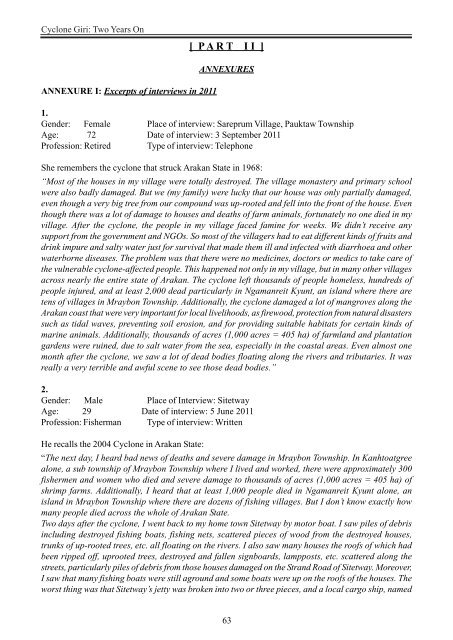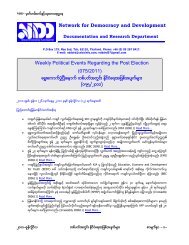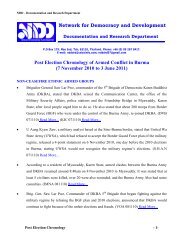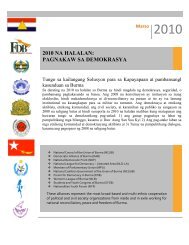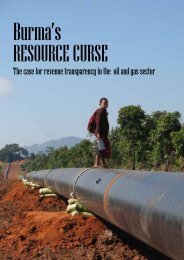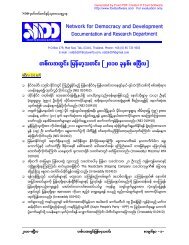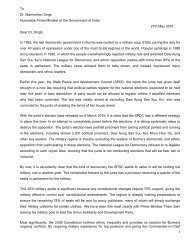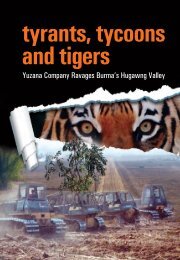Cyclone Giri - Two Years On - Burma Action Ireland
Cyclone Giri - Two Years On - Burma Action Ireland
Cyclone Giri - Two Years On - Burma Action Ireland
Create successful ePaper yourself
Turn your PDF publications into a flip-book with our unique Google optimized e-Paper software.
<strong>Cyclone</strong> <strong>Giri</strong>: <strong>Two</strong> <strong>Years</strong> <strong>On</strong><br />
[ P A R T I I ]<br />
ANNEXURE I: Excerpts of interviews in 2011<br />
ANNEXURES<br />
1.<br />
Gender: Female Place of interview: Sareprum Village, Pauktaw Township<br />
Age: 72 Date of interview: 3 September 2011<br />
Profession: Retired Type of interview: Telephone<br />
She remembers the cyclone that struck Arakan State in 1968:<br />
“Most of the houses in my village were totally destroyed. The village monastery and primary school<br />
were also badly damaged. But we (my family) were lucky that our house was only partially damaged,<br />
even though a very big tree from our compound was up-rooted and fell into the front of the house. Even<br />
though there was a lot of damage to houses and deaths of farm animals, fortunately no one died in my<br />
village. After the cyclone, the people in my village faced famine for weeks. We didn’t receive any<br />
support from the government and NGOs. So most of the villagers had to eat different kinds of fruits and<br />
drink impure and salty water just for survival that made them ill and infected with diarrhoea and other<br />
waterborne diseases. The problem was that there were no medicines, doctors or medics to take care of<br />
the vulnerable cyclone-affected people. This happened not only in my village, but in many other villages<br />
across nearly the entire state of Arakan. The cyclone left thousands of people homeless, hundreds of<br />
people injured, and at least 2,000 dead particularly in Ngamanreit Kyunt, an island where there are<br />
tens of villages in Mraybon Township. Additionally, the cyclone damaged a lot of mangroves along the<br />
Arakan coast that were very important for local livelihoods, as firewood, protection from natural disasters<br />
such as tidal waves, preventing soil erosion, and for providing suitable habitats for certain kinds of<br />
marine animals. Additionally, thousands of acres (1,000 acres = 405 ha) of farmland and plantation<br />
gardens were ruined, due to salt water from the sea, especially in the coastal areas. Even almost one<br />
month after the cyclone, we saw a lot of dead bodies floating along the rivers and tributaries. It was<br />
really a very terrible and awful scene to see those dead bodies.”<br />
2.<br />
Gender: Male Place of Interview: Sitetway<br />
Age: 29 Date of interview: 5 June 2011<br />
Profession: Fisherman Type of interview: Written<br />
He recalls the 2004 <strong>Cyclone</strong> in Arakan State:<br />
“The next day, I heard bad news of deaths and severe damage in Mraybon Township. In Kanhtoatgree<br />
alone, a sub township of Mraybon Township where I lived and worked, there were approximately 300<br />
fishermen and women who died and severe damage to thousands of acres (1,000 acres = 405 ha) of<br />
shrimp farms. Additionally, I heard that at least 1,000 people died in Ngamanreit Kyunt alone, an<br />
island in Mraybon Township where there are dozens of fishing villages. But I don’t know exactly how<br />
many people died across the whole of Arakan State.<br />
<strong>Two</strong> days after the cyclone, I went back to my home town Sitetway by motor boat. I saw piles of debris<br />
including destroyed fishing boats, fishing nets, scattered pieces of wood from the destroyed houses,<br />
trunks of up-rooted trees, etc. all floating on the rivers. I also saw many houses the roofs of which had<br />
been ripped off, uprooted trees, destroyed and fallen signboards, lampposts, etc. scattered along the<br />
streets, particularly piles of debris from those houses damaged on the Strand Road of Sitetway. Moreover,<br />
I saw that many fishing boats were still aground and some boats were up on the roofs of the houses. The<br />
worst thing was that Sitetway’s jetty was broken into two or three pieces, and a local cargo ship, named<br />
63


